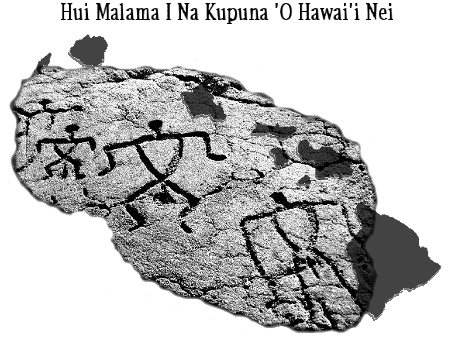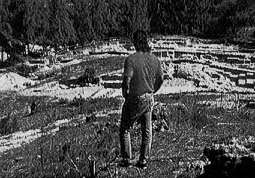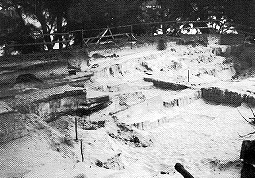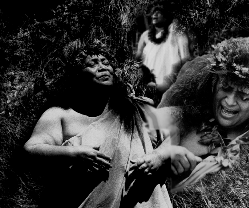

 Mokapu and Heleloa |
 Ki'i La`au |
 Missing Iwi |


 Hui Malama I Na Kupuna O Hawai`i Nei (Group Caring For the Ancestors
of Hawai`i) is a Native Hawaiian Organization dedicated to the proper treatment
of ancestral Native Hawaiians. Hui Malama I Na Kupuna O Hawai`i Nei was
born December 1988 from the kaumaha (heaviness) and aokanaka
(enlightenment) caused by the archaeological disinterment of over 1,100
ancestral Native Hawaiians from Honokahua, Maui. The ancestral remains
were removed over the protests of the Native Hawaiian community in order
to build the Ritz Carlton Hotel. The desecration was stopped following
a 24-hour vigil at the State Capital. Governor John Waihe`e, a Native Hawaiian,
approved of a settlement that returned the ancestral remains to their one
hanau (birth sands), set aside the reburial site in perpetuity, and
moved the hotel inland and away from the ancestral resting place. Ironically,
Native Hawaiians fighting the approval of the Ritz Carlton Hotel project
advocated for the hotel to be moved away from the ancestral burial site
to begin with. Today, stone memorials and plaques mark the location of
the reinterment site, a chilly reminder of the pain, anguish, and shame
that could have been avoided if State and County officials and the private
landowner/developer had only listened to those who demanded the the hotel
not be built, or at least moved away from the Honokahua families.
Hui Malama I Na Kupuna O Hawai`i Nei (Group Caring For the Ancestors
of Hawai`i) is a Native Hawaiian Organization dedicated to the proper treatment
of ancestral Native Hawaiians. Hui Malama I Na Kupuna O Hawai`i Nei was
born December 1988 from the kaumaha (heaviness) and aokanaka
(enlightenment) caused by the archaeological disinterment of over 1,100
ancestral Native Hawaiians from Honokahua, Maui. The ancestral remains
were removed over the protests of the Native Hawaiian community in order
to build the Ritz Carlton Hotel. The desecration was stopped following
a 24-hour vigil at the State Capital. Governor John Waihe`e, a Native Hawaiian,
approved of a settlement that returned the ancestral remains to their one
hanau (birth sands), set aside the reburial site in perpetuity, and
moved the hotel inland and away from the ancestral resting place. Ironically,
Native Hawaiians fighting the approval of the Ritz Carlton Hotel project
advocated for the hotel to be moved away from the ancestral burial site
to begin with. Today, stone memorials and plaques mark the location of
the reinterment site, a chilly reminder of the pain, anguish, and shame
that could have been avoided if State and County officials and the private
landowner/developer had only listened to those who demanded the the hotel
not be built, or at least moved away from the Honokahua families.
 Honokahua represents balance, for from this tragedy
came enlightment: the realization by living Native Hawaiians that we were
ultimately responsible for the care and protection of our ancestors and
that cultural protocols needed to be relearned and laws effectively changed
to create the empowerment necessary to carry out this important and time
honored responsibility to malama (take care) and kupale (protect)
our ancestors.
Honokahua represents balance, for from this tragedy
came enlightment: the realization by living Native Hawaiians that we were
ultimately responsible for the care and protection of our ancestors and
that cultural protocols needed to be relearned and laws effectively changed
to create the empowerment necessary to carry out this important and time
honored responsibility to malama (take care) and kupale (protect)
our ancestors.



E homai ka ike, e homai ka ikaika, e homai ka akamai, e homai ka maopopo pono, e homai ka `ike papalua, e homai ka mana
Grant us knowledge, grant us strength, grant us intelligence, grant us righteous understanding, grant us visions and avenues of communication, grant us mana.
Moreover, we have been taught that the relationship between our ancestors and ourselves is one of interdependence- as the living, we have a kuleana (responsibility) to care for our kupuna (ancestors). In turn, our ancestors respond by protecting us on the spiritual side. Hence, one side cannot completely exist without the other.
Repatriation and burial site protection required changes in federal and state laws. Hui Malama I Na Kupuna O Hawai`i Nei is honored to have participated in successful efforts to enact the National Museum of the American Indian Act (P.L. 101-185, November, 1989, "NMAIA") and the Native American Grave Protection and Repatriation Act ("NAGPRA") (P.L. 101-601, November 16, 1990). Although Native Hawaiians are not formally recognized as Native Americans, for purposes of NMAIA and NAGPRA, Native Hawaiians enjoy Native American status. Moreover, Native Hawaiian organizations enjoy legal authorities comparable to Indian tribes. Hui Malama I Na Kupuna O Hawai`i Nei and the Office of Hawaiian Affairs are specifically named as Native Hawaiian organizations eligible to conduct repatriation of cultural items and to participate in consultation relating to the treatment of inadvertently discovered Native Hawaiian remains and other cultural items on Federal and Hawaiian Home lands.
NAGPRA gave Hui Malama I Na Kupuna O Hawai`i Nei legal standing to bring the ancestors home back to their `ohana and to protect the sanctity of traditional burial sites. This meant contacting museums nation wide to inquire whether the institution housed Native Hawaiian skeletal remains or funerary objects and if so, begin the process of repatriation and reinterment.
Moreover, the passage of Act 306 in 1990 has provided a higher degree of protection for Native Hawaiian burial and reburial sites in the State of Hawai`i through the creation of island burial councils comprised of a majority of Native Hawaiians, as well as representatives of large landowners and developers. The councils have the legal authority to determine whether to preserve in place or relocate previously identified Native Hawaiian burial sites situate on state, county, and private land. In addition, the councils have the authority to render recommendations regarding any burial related matter, including the treatment of inadvertently discovered Native Hawaiian skeletal remains.
Completed Repatriations from National and International Institutions:
Hui Malama I Na Kupuna O Hawai`i Nei has repatriated and reinterred ancestral Native Hawaiian remains and funerary objects from the following institutions:
National
 Smithsonian National Museum of Natural History (Washington,
D.C.)
Smithsonian National Museum of Natural History (Washington,
D.C.)
 Sacramento Science Center (Sacramento, California)
Sacramento Science Center (Sacramento, California)
 University of Kansas Dept. of Anthropology (Lawrence, Kansas)
University of Kansas Dept. of Anthropology (Lawrence, Kansas)
International
Museums with pending repatriation claims:
Yale Peabody Museum Harvard Peabody Museum
I wish to make the following suggestions to assist tribes with repatriation efforts.
First, and above all else, follow your own teachings and draw strength, guidance, and inspiration from your heritage. Adapt NAGPRA to your indigenous culture.
Second, establish a working relationship with museum staff. The effort will help establish and clarify the museum's philosophy with regard to NAGPRA compliance.
Third, identify the decision-making process or hierarchy at the museum. Be clear who the decision makers are and make it clear to the museum who your decision makers are.
Fourth, for purposes of clarity, reduce discussions to writing wherever possible. Leave little to assumption. Moreover, copy the National Park Service NAGPRA program on correspondences.
Fifth, in problematic cases with uncooperative museums, ask your congressional delegation to write letters or make telephone calls. In extremely problematic cases - and where the culture agrees - use the media to convey your intentions. We have found from experience that society in general agrees with good faith efforts to return ancestral remains, rather than with museum demands to withhold them from reburial.
Finally, whenever making an assertion, ask the museum official to explain back to you what they think you meant. For example, we may say to Museum X, "Don't study our ancestors." By this we mean no taking or gleaning of any scientific data whatsoever. However, the museum may think we meant, "minimal recording of age, sex stature, pathologies, cranial measurements, dentition, and ethnicity determination is acceptable, but not intrusive examinations such as DNA analysis or carbon dating."
 If we do not clarify what we mean, the museum may think it adequately
consulted with us. For their part, encourage museums to request clarification
of any statement or action by the group or any member.
If we do not clarify what we mean, the museum may think it adequately
consulted with us. For their part, encourage museums to request clarification
of any statement or action by the group or any member.
-Edward Halealoha Ayau-
![]() Authored by Richard
W. Pell
Authored by Richard
W. Pell
email: rp3h@andrew.cmu.edu